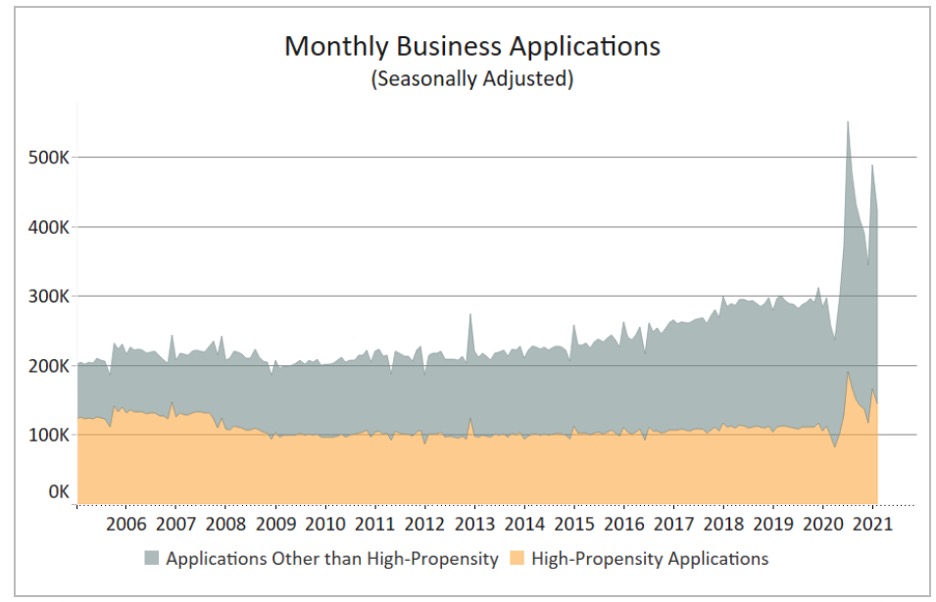
It’s an understatement to say that the U.S. economy went on a wild ride in 2020. The COVID-19 pandemic and subsequent lockdowns led to severe contractions in the second quarter. Reopenings in many states led to dramatic growth in the third quarter, followed by some more growth in the fourth quarter.
Many established businesses had a difficult time during this kind of a roller coaster, but what was it like for new entrepreneurs? Well, the latest business formation statistics are in from the U.S. Census Bureau and there was a MAJOR uptick in applications for startup enterprises in 2020.

There were 4.4 million new business applications in 2020. By comparison, there were 3.47 million applications in 2019, and that represented a decline from 2018.
Needless to say, this is unusual economic behavior—particularly in light of the global pandemic.
The last severe economic disruption came with the financial crash of 2007 and the recession of 2008 that followed. There was a decrease in new business formation then, something that is typical during tough economic times.
So why the counterintuitive behavior in 2020?
Theories abound. Many of them theoretically make sense on the surface, but only a handful can be supported with data.
Did high unemployment drive up entrepreneurship?
One theory is that with the high unemployment rates of Q2, people were forced to start their own businesses. The problem with this theory, though, is that it doesn’t account for why 2020 would be different from 2008 or any other recession year.
What about remote working and telecommuting?
Another theory suggests that remote work triggered the uptick. When people work remotely, they save time on commuting and have considerably more flexibility. People used that time to pursue the business they had always wanted to start but never got around to. It’s certainly plausible, though more data is needed.
Another study delved into whether there was a correlation between states that reported high remote work frequency in 2019 were the ones leading the way for new business formation in 2020. No correlation could be established.
Undoubtedly, this theory does apply in some individual cases. Perhaps in the future, more data will be available. But for now, the connection between remote work and entrepreneurship isn’t well established. Both of the theories above presume that the new businesses are more “gigs” that can be started on the side (for remote workers) or with very little money (presumably the unemployed aren’t sitting on a reservoir of capital). These types of businesses would not be expected to have a huge economic impact, given that they are generally one-person operations.
High-propensity businesses trend upwards
Interestingly, the Census data goes deeper and breaks down business formation applications into categories, one of which is called “high-propensity businesses.” That’s a business that will have a payroll. The Census makes this determination either directly (the business has indicated hiring plans in the application) or indirectly (the business has employees).
High-propensity business applications increased in 2020, which may be the most counter-intuitive thing of all about the data. Last year, we not only saw entrepreneurship but the high-overhead kind of businesses that produce jobs for other people right out of the chute.
What might account for this?
Another theory raised is that these were planned ventures and people didn’t stop their plans simply because of the pandemic, but that seems unlikely. The surge was primarily driven by people in online retailing, a business idea perfectly suited to a society where everyone was suddenly ordering from home. It’s unlikely everyone was planning to do that in January 2020 and then a pandemic created the perfect conditions.
What is possible is that the pandemic created conditions that worked in favor of people starting online retail shops that required employees. The rise in remote work led to buildings being empty. Certainly, those who rent out office space for a living found their leverage significantly reduced. That may have resulted in lower costs for storage, which in turn made large-scale online retail more affordable.
It has to be emphasized the storage space theory is just that: a theory. As 2020 moves further into the rearview mirror, more data will come forward and help paint a more precise picture of what happened during this historic year in the American and global economies.
What we can say for certain is that new business formation boomed and it was done by people who want to make sure employees prosper along with them.


